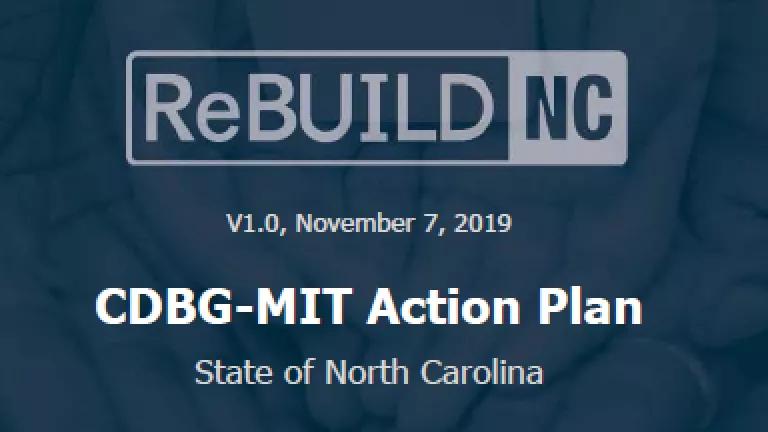NC's Missing the Big Picture on Climate Resilience
NC is applying for $168 million from HUD's CDBG-MIT fund. But NC is proposing to focus on a narrow range of projects and missing the larger opportunity to use these funds to make much-needed changes to a range of local and state and programs.

North Carolina will soon submit its application for $168 million to the U.S. Department of Housing and Urban Development (HUD) for disaster resilience funding. But the state is missing a huge opportunity to use these funds to better prepare for the coming impacts of climate change and address the vulnerabilities exposed by Hurricanes Matthew (2016), Florence (2018), and Dorian (2019). NRDC filed comments on North Carolina's CDBG-MIT application and made several recommendations for how it could better advance climate resilience efforts.
The state has proposed to expand its efforts to buy out homes damaged by Hurricanes Matthew and Florence and develop new affordable housing, which is great. But the state's application is missing the big picture.
North Carolina is one of nine states and five local jurisdictions eligible for a combined $6.875 billion in HUD funding that is specifically for disaster mitigation programs. This new funding opportunity is known as the Community Development Block Grant Mitigation program, or CDBG-MIT. When HUD announced the availability of funding, it stated, "While it is impossible to eliminate all risks, CDBG-MIT funds will enable grantees to mitigate against disaster risks, while at the same time allowing grantees the opportunity to transform State and local planning."
As proposed, North Carolina's application for these funds is not going to accomplish HUD's goals. Nor is the application adequately supporting Governor Roy Cooper's call to agencies to “integrate climate adaptation and resiliency planning into policies, programs, and operations,” as required by his Executive Order 80.
In general, the application developed by the North Carolina Office of Recovery and Resiliency (NCORR), also known as a Draft Action Plan, needs to be improved in five important ways.
1. The state needs to do a meaningful assessment of future risks, as required by HUD, or at least commit to using these funds to do such an assessment. For example, the plan only examines past sea level rise through 2016 and completely ignores future projections. North Carolina’s Coastal Commission has projections for the next three decades that could have been used. The National Climate Assessment and reports from the International Panel on Climate Change (that say several feet of sea level rise is possible by the end of the century) are also readily available resources the state should have used. It is also important to note that the state has already initiated development of a Climate Risk Assessment and Resilience Plan, at the Governor's direction, which will include an assessment of future climate conditions. However, that effort is not even recognized in this application nor is there any commitment to supporting it, even though it's exactly the kind of thing HUD wants to encourage and support.
2. The state must go further to meet HUD’s CDBG-MIT goal of improving states' long-term plans, policies, programs, and practices. HUD wants to "build the capacity of States and local governments to comprehensively analyze disaster risks and to update hazard mitigation plans through the use of data and meaningful community engagement” and “support the adoption of policies that reflect local and regional priorities that will have long-lasting effects on community risk reduction.” North Carolina is not taking advantage of that opportunity to support development of future-oriented hazard mitigation plans, improve state and local building codes, update risk maps, or a host of other activities that could better prepare the state for an uncertain future.
3. As proposed, the draft application does not reflect Governor Cooper’s resilience directive set forth in Executive Order 80 to “integrate climate adaptation and resiliency planning into policies, programs, and operations.” NCORR should be leading the way in the state's efforts to use climate science to improve its decisions about where it's safe to build and where communities can reduce their vulnerability. NCORR should also be setting the example for other state agencies on how to make climate adaptation and resilience part of their mission, just as Governor Cooper has ordered. The proposed application does not do that.
4. The proposed projects (buyouts/acquisitions and affordable housing) have a lot of merit, but implementation needs to be more fully described by NCORR. The state is looking at acquiring up to 2,300 properties, but there is little information on how those properties will be selected, whether redevelopment will be allowed after the state pays to acquire them, what kind of redevelopment would be allowed in areas known to flood, or how properties might have natural infrastructure built to further lower flood risks. The commitment to develop new affordable housing is encouraging, but the state plans to exclude renters and rental properties from the buyout/acquisition program. Doing so would leave many lower income residents living in flood prone areas.
5. The state's application does not leverage any of the $168 million, even though multiple opportunities to leverage CDBG-MIT funds exist in North Carolina. HUD was very clear that it wanted states to demonstrate how other federal funding, local and state capital budgets, and other sources of public and private capital could leverage these funds, but North Carolina's application essentially proposes to spend $168 million on some well-intentioned projects, and that's it. The application is also not leveraging the hundreds of millions in federal disaster aid the state has already received from the Federal Emergency Management Agency (FEMA) and HUD. North Carolina will also be eligible for an additional $336.5 million from HUD that can also support similar projects.
North Carolina's application to HUD should be a critical component in the State’s overall strategy for enhancing its resilience to the impacts of climate change. It should have clear linkage to the State’s Climate Risk Assessment and Resilience Plan (now under development and required by Governor Cooper in Executive Order 80), the State Hazard Mitigation Plan prepared by NC Emergency Management, as well as the funding now available to North Carolina through federal disaster aid and mitigation programs and other state agency grant programs.
The CDBG-MIT funding is the best opportunity the state has to get access to resources that allow it to expanded planning activities, support development of climate-informed building and zoning codes, invest in updating regulations that take future conditions into account, and develop a statewide climate risk assessment, as called for by Governor Cooper.
We hope the state amends its draft application, builds on the project ideas proposed, and expands the scope of its application to include these kinds of activities. It's what HUD wants to see in applications for CDBG-MIT funding. It's what Governor Cooper has directed his agencies to do. And it's the right thing to do in the face of climate change.




